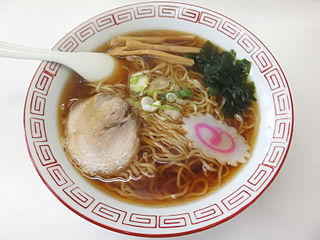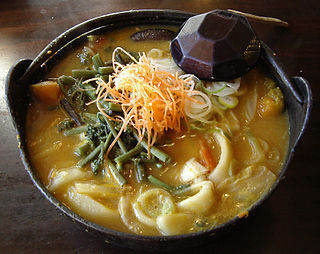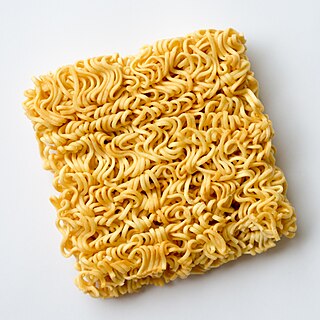
Japanese cuisine encompasses the regional and traditional foods of Japan, which have developed through centuries of political, economic, and social changes. The traditional cuisine of Japan is based on rice with miso soup and other dishes with an emphasis on seasonal ingredients. Side dishes often consist of fish, pickled vegetables, and vegetables cooked in broth. Common seafood is often grilled, but it is also sometimes served raw as sashimi or as sushi. Seafood and vegetables are also deep-fried in a light batter, as tempura. Apart from rice, a staple includes noodles, such as soba and udon. Japan also has many simmered dishes, such as fish products in broth called oden, or beef in sukiyaki and nikujaga.

Ramen is a Japanese noodle dish. It includes Chinese-style wheat noodles served in a broth. Common flavors are soy sauce and miso, with typical toppings including sliced pork, nori, menma, and scallions. Ramen has its roots in Chinese noodle dishes and is a part of Japanese Chinese cuisine. Nearly every region in Japan has its own variation of ramen, such as the tonkotsu ramen of Kyushu and the miso ramen of Hokkaido.

Noodles are a type of food made from unleavened dough which is either rolled flat and cut, stretched, or extruded, into long strips or strings. Noodles are a staple food in many cultures and made into a variety of shapes. The most common noodles are those derived from either Chinese cuisine or Italian cuisine. Chinese noodles are known by a variety of different names, while Italian "noodles" are known as pasta.

Top Ramen is an American brand of instant ramen noodles introduced in 1970 by Nissin Foods.

Nissin Foods Holdings Co., Ltd. is a Japanese food company. Founded by Momofuku Ando in 1948 in Izumiōtsu, Osaka, it owns Nissin Food Products, Nissin Chilled Foods, Nissin Frozen Foods, and Myojo Foods. It is known for development of the world's first marketed brand of instant noodles Chicken Ramen and products like Cup Noodles, Yakisoba U.F.O., and Demae Iccho.

Cup Noodles is a brand of cup instant ramen developed in 1971 and manufactured by Japanese food company Nissin Foods. Single servings of the product are packaged in foam, plastic, or paper cups and are prepared by adding boiling water.

Ajinomoto Co., Inc. is a Japanese multinational food and biotechnology corporation which produces seasonings, interlayer insulating materials for semiconductor packages for use in personal computers, cooking oils, frozen foods, beverages, sweeteners, amino acids, and pharmaceuticals. Aji-No-Moto is the trade name for the company's original monosodium glutamate (MSG) product, the first of its kind, since 1909. The corporation's head office is located in Chūō, Tokyo. As of 2023, Ajinomoto operates in 34 countries worldwide and employs an estimated 34,615 people. Its yearly revenue in 2023 is around ¥1.44 trillion JPY or $9.1 billion USD.
Sapporo Ichiban (サッポロ一番) is a brand of instant noodles manufactured by Sanyo Foods of Maebashi, Gunma, Japan. Sapporo Ichiban noodles are also manufactured in Garden Grove, California, for the United States and Canadian market.

Japanese cuisine has a vast array of regional specialities known as kyōdo ryōri (郷土料理) in Japanese, many of them originating from dishes prepared using local ingredients and traditional recipes.

Instant soup is a type of soup designed for fast and simple preparation. Some are homemade, and some are mass-produced on an industrial scale and treated in various ways to preserve them. A wide variety of types, styles and flavors of instant soups exist. Commercial instant soups are usually dried or dehydrated, canned, or treated by freezing.

Hōtō (ほうとう) is a noodle soup and popular regional dish originating from Yamanashi, Japan made by stewing flat udon noodles and vegetables in miso soup. Though hōtō is commonly recognized as a variant of udon, locals do not consider it to be an udon dish because the dough is prepared in the style of dumplings rather than noodles.

Instant noodles, or instant ramen, is a type of food consisting of noodles sold in a precooked and dried block with flavoring powder and/or seasoning oil. The dried noodle block was originally created by flash-frying cooked noodles, which is still the main method used in Asian countries; air-dried noodle blocks are favored in Western countries. Dried noodle blocks are designed to be cooked or soaked in boiling water before eating. Ramen, a Japanese adaptation of Chinese noodle soup, is sometimes used as a descriptor for instant noodle flavors by some Japanese manufacturers. It has become synonymous in the United States with all instant noodle products.

Luosifen is a Chinese noodle soup and specialty of Liuzhou, Guangxi. The dish consists of rice noodles boiled and served in a soup. The stock that forms the soup is made by stewing river snails and pork bones for several hours with black cardamom, fennel seed, dried tangerine peel, cassia bark, cloves, white pepper, bay leaf, licorice root, sand ginger, and star anise. It usually does not contain snail meat, but it is instead served with pickled bamboo shoot, pickled green beans, shredded wood ear, fu zhu, fresh green vegetables, peanuts, and chili oil added to the soup. Many often recognize this noodle dish as something stinky. This dish is full of umami and attracts many not just in China but also outside of China to visit just for this dish. Diners can also add chili, green onions, white vinegar, and green peppers to suit their taste.

Cup Noodles is a brand of cup instant ramen developed in 1971 and manufactured by the Japanese food company Nissin Foods. The product was first introduced in the United States as "Cup O' Noodles" in 1972, before being renamed to "Cup Noodles" in 1993.

A ramen shop is a restaurant that specializes in ramen dishes, the wheat-flour Japanese noodles in broth. In Japan, ramen shops are very common and popular, and are sometimes referred to as ramen-ya(ラーメン屋) or ramen-ten(ラーメン店). Some ramen shops operate in short-order style, while others provide patrons with sit-down service. Over 10,000 ramen shops exist in Japan. In recent times, ramen shops have burgeoned in some cities in the United States, such as Chicago, Los Angeles, and New York City.

North Korean cuisine is the traditional culinary practices and dishes of North Korea. Its foundations are laid by the agricultural and nomadic traditions in southern Manchuria and the Korean Peninsula. Some dishes are shared by the two Koreas; however, availability and quality of Northern cuisine is much more significantly affected by sociopolitical class divides.















